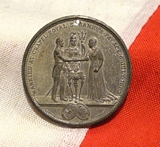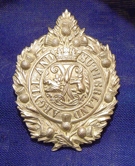Antique Arms & Militaria
A Victorian, 1860's Queens Westminster Volunteers Silver Buckle
A super silver buckle, with excellent detail and quality. 6cm read more
120.00 GBP
A Victorian British Connaught Rangers Officer's Helmet Tin
the case which is emblazoned with the makers name Hawkes and a brass plaque with the officer's name and regiment engraved, Addis Delacombe Esq Connaught Rangers. The 1st Battalion deployed to South Africa as part of 5th (Irish) Brigade which was commanded by Major-General Fitzroy Hart. The Rangers took part in numerous engagements during the Boer War.
The regiment took part in the Battle of Colenso on 15 December, part of the attempt to relieve the town of Ladysmith, besieged by Boer forces. The Rangers and the rest of the 5th (Hart's) Brigade, who were on the left flank, had been forced to perform over 20 minutes of drill before the advance. The Brigade suffered heavily during their participation in the battle, the Boers inflicting heavy casualties. The advance was met with a fire from three sides that forced them to withdraw. The battle ended in defeat for the British. That battle and two previous defeats at Magersfontein and Stormberg became known as 'Black Week'.
The Rangers fought at Spion Kop and the Tugela Heights during further attempts by General Sir Redvers Buller to relieve the besieged town of Ladysmith. In late February the siege of Ladysmith finally came to an end after it was relieved by British forces. The regiment was awarded the battle honour Relief of Ladysmith in addition to South Africa 1899?1902.
The 5th Brigade subsequently deployed to Kimberley and took part in further operations against the Boer guerillas.
The Rangers finally departed South Africa for Ireland after the Boer War ended in 1902, and were also awarded the theatre honour.
In 1908 the 1st Battalion arrived in India while the 2nd Battalion returned home to Ireland. The 1st and 2nd battalions of the regiment were given new Colours by HM King George V in 1911. The 2nd Battalion had left Ireland and was in England when the "war to end all wars", the First World War, began in August 1914. This tin is in untouched condition and could be much improved with simple cleaning but we have left 'as is' for those that prefer it as such. read more
200.00 GBP
Historical Medal For the Marriage of the Duke of York & Princess Mary 1893
Married At Chapel Royal St James's Palace 6 July 1893. Reverse with Duke and Duchess standing before Brittania Made by Spink and Sons London. Silvered on metal. 51mm. read more
85.00 GBP
A Khedive Star Medal
Five pointed star with a central raised circle bearing an image of the Sphinx with the Pyramids behind, the word ?EGYPT? above followed by a year (for the first three issues and undated for the fourth) with the same written in Arabic below. The reverse has the monogram of the Khedive under a crown within a raised circle. The Khedive of Egypt presented a bronze star to all Officers and men of the Navy and Army who were engaged in the suppression of the rebellion of Egypt in 1882. The suspender [lacking] was straight with a crescent and five pointed star in the centre which is attached to the star with a small metal loop passing through a small ring between the two top points of the star. Ist issue dated 1882. Good Very Fine condition. No ribbon,mount.Unnamed as issued. read more
65.00 GBP
Argyll and Sutherland Highlanders Glengarry Badge 1882 to 1900 Pattern
In pressed nickel with good clear definition and in good condition, 2 lugs. read more
45.00 GBP
French 1830'S Shako Helmet Plate
Brass plate of Cockerel and stamp of 'Return to Liberty' July 1830 read more
90.00 GBP
French 1830's Shako Helmet Plate.
Copper plate of a Cockerel over French symbols. read more
90.00 GBP








